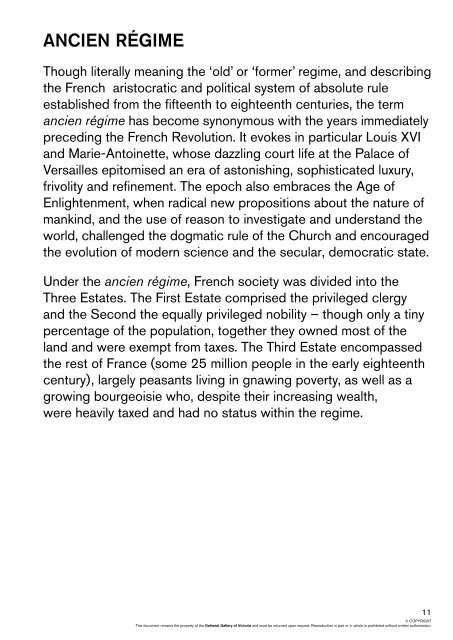Exhibition labels & didactics - National Gallery of Victoria
Exhibition labels & didactics - National Gallery of Victoria Exhibition labels & didactics - National Gallery of Victoria
10 Nicolas-André MONSIAU French 1754–1837 Louis XVI giving his instructions to the Comte de La Pérouse Louis XVI donne ses instructions au Capitaine de vaisseau La Pérouse 1817 oil on canvas Versailles, musée national du château MV 220 In this painting Louis XVI points on the map held by La Pérouse to a spot in the Indian Ocean off the Australian coast. The exploration of the northern and western coastlines of Australia was originally to be part of La Pérouse’s mission. Louis XVI’s concern for La Pérouse’s safety, following the explorer’s disappearance, remained undiminished even during his incarceration in the Temple Prison during the French Revolution. Each morning the King apparently asked his jailers: ‘Is there any news yet of Monsieur de La Pérouse?’ The NGV warmly thanks Harold and Krystyna Campbell-Pretty for their generous support in bringing this work to Australia. © COPYRIGHT This document remains the property of the National Gallery of Victoria and must be returned upon request. Reproduction in part or in whole is prohibited without written authorisation.
ANCIEN RÉGIME Though literally meaning the ‘old’ or ‘former’ regime, and describing the French aristocratic and political system of absolute rule established from the fifteenth to eighteenth centuries, the term ancien régime has become synonymous with the years immediately preceding the French Revolution. It evokes in particular Louis XVI and Marie-Antoinette, whose dazzling court life at the Palace of Versailles epitomised an era of astonishing, sophisticated luxury, frivolity and refinement. The epoch also embraces the Age of Enlightenment, when radical new propositions about the nature of mankind, and the use of reason to investigate and understand the world, challenged the dogmatic rule of the Church and encouraged the evolution of modern science and the secular, democratic state. Under the ancien régime, French society was divided into the Three Estates. The First Estate comprised the privileged clergy and the Second the equally privileged nobility – though only a tiny percentage of the population, together they owned most of the land and were exempt from taxes. The Third Estate encompassed the rest of France (some 25 million people in the early eighteenth century), largely peasants living in gnawing poverty, as well as a growing bourgeoisie who, despite their increasing wealth, were heavily taxed and had no status within the regime. © COPYRIGHT This document remains the property of the National Gallery of Victoria and must be returned upon request. Reproduction in part or in whole is prohibited without written authorisation. 11
- Page 1 and 2: Exhibition labels & didactics
- Page 3 and 4: Jean-Baptiste LEMOYNE French 1704-7
- Page 5 and 6: NAPOLEON AND JOSEPHINE Napoleone Bu
- Page 7 and 8: Louis Antoine MILET-MUREAU French 1
- Page 9: J. M. MOREAU le Jeune French 1741-1
- Page 13 and 14: PAINTERS OF THE CABINET DU ROI Éli
- Page 15 and 16: THE FRENCH REVOLUTION AND REIGN OF
- Page 17 and 18: ATELIER BASSET, Paris France active
- Page 19 and 20: NEVERS, Burgundy Revolutionary plat
- Page 21 and 22: FRANCE Cockade Cocarde 1790 fabric
- Page 23 and 24: FRANCE The French Constitution as d
- Page 25 and 26: Jacques Louis PERÉE engraver Frenc
- Page 27 and 28: Jacques Julien Houtou de LABILLARDI
- Page 29 and 30: Jean-François GARNERAY French 1755
- Page 31 and 32: Jean-François SABLET Swiss 1745-18
- Page 33 and 34: Hubert ROBERT French 1733-1808 A co
- Page 35 and 36: FRANCE M. and Mme. Darbouville in t
- Page 37 and 38: Charles BENAZECH English 1767/68-17
- Page 39 and 40: FRANCE Claude BORNET (after) Marie-
- Page 41 and 42: Isidore-Stanislas HELMAN engraver F
- Page 43 and 44: NAPOLEON’S RISE TO POWER The prom
- Page 45 and 46: Joseph COTEAU enameller French 1740
- Page 47 and 48: Louis GAUFFIER French 1762-1801 The
- Page 49 and 50: Charles-Louis CORBET French 1758-18
- Page 51 and 52: FRANCE Pair of Sphinx fireplace gua
- Page 53 and 54: François-Louis-Joseph WATTEAU Fren
- Page 55 and 56: TURKEY The First Consul’s sabre,
- Page 57 and 58: Jacques-Nicolas Paillot de MONTABER
- Page 59 and 60: MANUFACTURE DE SÈVRES manufacturer
ANCIEN RÉGIME<br />
Though literally meaning the ‘old’ or ‘former’ regime, and describing<br />
the French aristocratic and political system <strong>of</strong> absolute rule<br />
established from the fifteenth to eighteenth centuries, the term<br />
ancien régime has become synonymous with the years immediately<br />
preceding the French Revolution. It evokes in particular Louis XVI<br />
and Marie-Antoinette, whose dazzling court life at the Palace <strong>of</strong><br />
Versailles epitomised an era <strong>of</strong> astonishing, sophisticated luxury,<br />
frivolity and refinement. The epoch also embraces the Age <strong>of</strong><br />
Enlightenment, when radical new propositions about the nature <strong>of</strong><br />
mankind, and the use <strong>of</strong> reason to investigate and understand the<br />
world, challenged the dogmatic rule <strong>of</strong> the Church and encouraged<br />
the evolution <strong>of</strong> modern science and the secular, democratic state.<br />
Under the ancien régime, French society was divided into the<br />
Three Estates. The First Estate comprised the privileged clergy<br />
and the Second the equally privileged nobility – though only a tiny<br />
percentage <strong>of</strong> the population, together they owned most <strong>of</strong> the<br />
land and were exempt from taxes. The Third Estate encompassed<br />
the rest <strong>of</strong> France (some 25 million people in the early eighteenth<br />
century), largely peasants living in gnawing poverty, as well as a<br />
growing bourgeoisie who, despite their increasing wealth,<br />
were heavily taxed and had no status within the regime.<br />
© COPYRIGHT<br />
This document remains the property <strong>of</strong> the <strong>National</strong> <strong>Gallery</strong> <strong>of</strong> <strong>Victoria</strong> and must be returned upon request. Reproduction in part or in whole is prohibited without written authorisation.<br />
11



